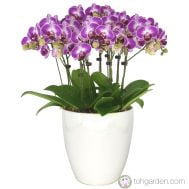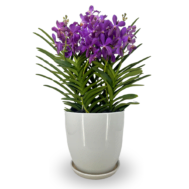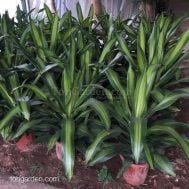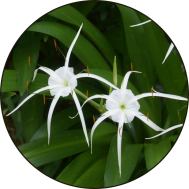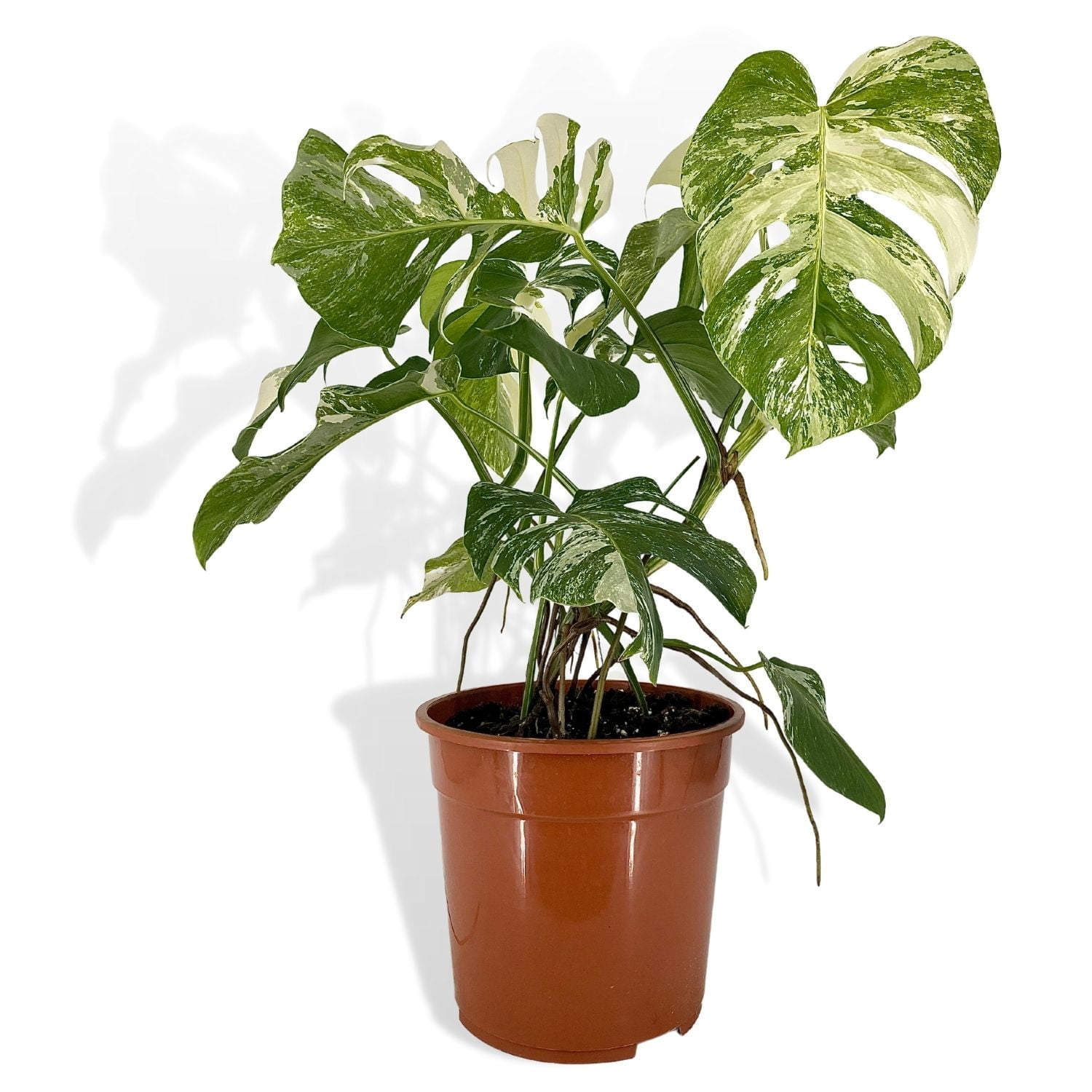
Sub Species: Monstera deliciosa borsigiana
Species: Monstera deliciosa
Genus: Monstera
Tribe: Monstereae
Plant Family: Araceae
Origin: Southern Mexico, South Panama
Soil Drainage: Excellent
Soil pH: Mildly Acidic
Introduction
Monstera is a hemiepiphyte, which means it is partly an epiphyte. Monstera seeds frequently sprout in the canopy of natural habitat, developing epiphytically at first. However, their roots eventually go downwards and make touch with dirt. Later in its life, it may self-produce by becoming a rooted vine climbing upward from the forest floor and utilizing roots to climb tree trunks, eventually breaking their primary connection to the ground but continuing to send lengthy roots into the soil.
Monstera deliciosa borsigiana is a Monstera deliciosa subspecies. It grows quickly and has smaller leaves than the real Monstera deliciosa. This post will discuss the variegated Monstera deliciosa borsigiana Albo, which has a cult following at the moment and, while it costs an arm and a leg, is still one of the most inexpensive variegated Monsteras! Monstera Borsigiana Albo Variegata has variegation as a consequence of spontaneous yet natural mutation. Commercial providers cultivate Monstera Borsigiana Albo Variegata from seeds; however, it is difficult to predict which seed will yield Monstera Borsigiana Albo Variegata versus green Monstera borsigiana until the seedling reaches a specific maturity level. This means farmers must plant 100 000 Monstera borsigiana seeds, nurture them, and hope for one (!) variegated Albo Monstera out of the bunch. So, sure, it is a complete fraud if you come across someone selling Monstera Borsigiana Albo Variegata seeds.
Commercial cultivation of Monstera Borsigiana Albo Variegata is likewise not possible. For starters, Monstera Borsigiana Albo Variegata may be highly unstable. Furthermore, growing Monstera Borsigiana Albo Variegata by cuttings can be tricky since these species are particularly water-sensitive and prone to rot. If you decide to acquire an unrooted Monstera Borsigiana Albo Variegata cutting, bear in mind that roots it is more complex than rooting non-variegated Monsteras. As a result, Monstera Borsigiana Albo Variegata prices are not falling as quickly as expected. Shop Here
Variegated Monstera Albo Care
SOIL
Knowing what Monstera’s native environment is like can help you make the best potting mix for your Monstera Borsigiana Albo Variegata. Monstera Borsigiana Albo Variegata is highly water-sensitive and prone to decay. The first and most crucial thing to remember is that the potting mix should be light, enabling plenty of air to reach the roots. Avoid using a peat-based commercial potting mix, especially if your Monstera Borsigiana Albo Variegata’s root structure is undeveloped. Peat holds water and becomes compacted over time. This implies that the roots will remain damp and not receive enough oxygen, causing your Monstera Borsigiana Albo Variegata’s mainly white leaves to rot and die. If you are unlucky, the plant will suffer from root rot, and it will be too late by the time you discover something is wrong.
LIGHT
It is critical that your Monstera Borsigiana Albo Variegata have plenty of morning sun, grow lights or natural solid light. Plants, as you may recall from Biology lessons, require photosynthesizing to survive. Green chlorophyll is necessary for photosynthesis. Because the white variegated regions of Monstera Borsigiana Albo Variegata leaves lack chlorophyll, they do not participate in photosynthesis, allowing the green parts of the leaves to perform all of the heavy work. Therefore, to live, Monstera borsigiana Albo Variegata will produce more green patches if not exposed to sunlight. In short, each new leaf on your variegated Monstera will make it greener.
HUMIDITY
Monstera Borsigiana Albo Variegata prefers humidity, ideally between 65 and 70 per cent. Please keep in mind that we are discussing air humidity.
Not the moisture in the soil. Leaves should not be misted. This is especially critical for immature Monstera Borsigiana Albo Variegata plants. If your space lacks humidity, combining many plants in one location or potting your Monstera Borsigiana Albo Variegata in a larger pot with other aroids might help. I discovered that grouping and mixing many aroids in one pot was incredibly useful – all of my previously struggling aroids entirely changed in this new setup. Alternatively, you may place a small dish filled with water someplace beneath your Monstera Borsigiana Albo Variegata to enhance humidity as the water evaporates from the dish.
WATERING
Monstera Borsigiana Albo Variegata, as I stated previously in the essay, is highly water sensitive. Before watering, I always let the soil dry. Put your Monstera Borsigiana Albo Variegata in the shower and give it a nice wash, allowing the soil to get saturated with water. This will help clean the dust off big leaves and condition the aerial roots. Allow all water to drain before re-potting the Monstera Borsigiana Albo Variegata; never leave a multicoloured Monstera in water.
FERTILIZER
The fertilizers I use interchangeably for most of my plants are fertilizer For Growing
PROPAGATION
Monstera Borsigiana Albo Variegata may be difficult to grow. If you are not a seasoned plant grower, I would advise you to avoid purchasing unrooted cuttings. The optimum time to propagate established plants is in the spring or early summer when the plants are actively developing.
Wrap moist sphagnum moss around the node with tiny areal roots and cover it with cling film for the best results. Keep the plant in a warm location, away from drafts and chilly air. Check the moss regularly to ensure that it is moist. After a while, you will see the areal root altering and developing; when this occurs, continue to modify the wrapping to allow more space for the root to create. Allow the root to grow as large as feasible with the setup you have. Next, remove the wrapping and, if possible, place a pot or container with moist sphagnum moss beneath the node and direct the roots into it – do not cut the stem yet. Allow the root system to grow.
If Monstera Borsigiana Albo Variegata has enormous areal roots that cannot be wrapped without breaking, guide them into a water-filled bottle. Initially, just the tip (1-2 inches) or the root should come into touch with water. Then, when the areal root begins to generate fresh white growth, it should be immersed in water.
Now that the plant has grown sufficiently, we may cut the stem and place the cutting in a potting mix. Because Monstera Borsigiana Albo Variegata roots are so delicate, avoid pushing them down. Another essential note: while potting Monstera Borsigiana Albo Variegata, make sure the bottom of the stem where the incision was made does not come into touch with soil; otherwise, it may decay.
If you’ve previously purchased an unrooted Monstera Borsigiana Albo Variegata cutting and suspect it’s going to decay, well… I can attempt to assist you in saving it, but this procedure’s success depends on the extent of the damage. First, remove the cutting from the water and set it aside to dry for a few hours. Next, fill a container with fluffed-up moist sphagnum moss, insert your cutting, and place it in a warm propagator. While the propagation region is warm and humid, make sure there is no water sitting on the bottom of the pot. It may take months, which is a positive indication. On the other hand, if the rot damage is severe enough, the plant will die quickly.

